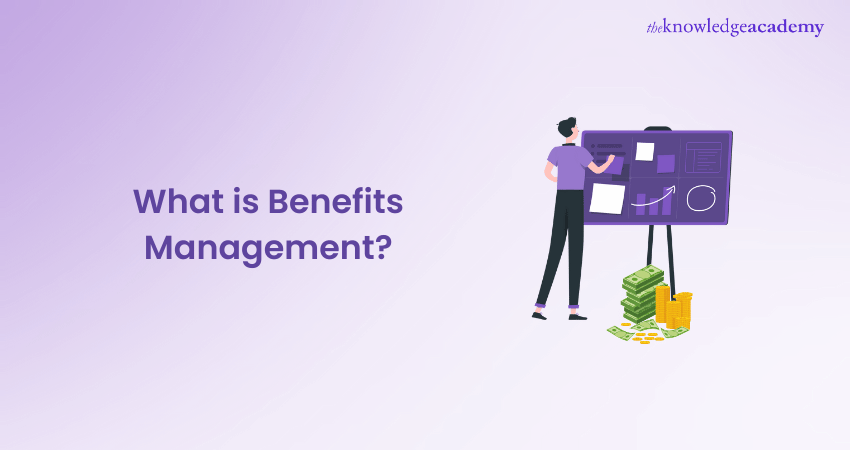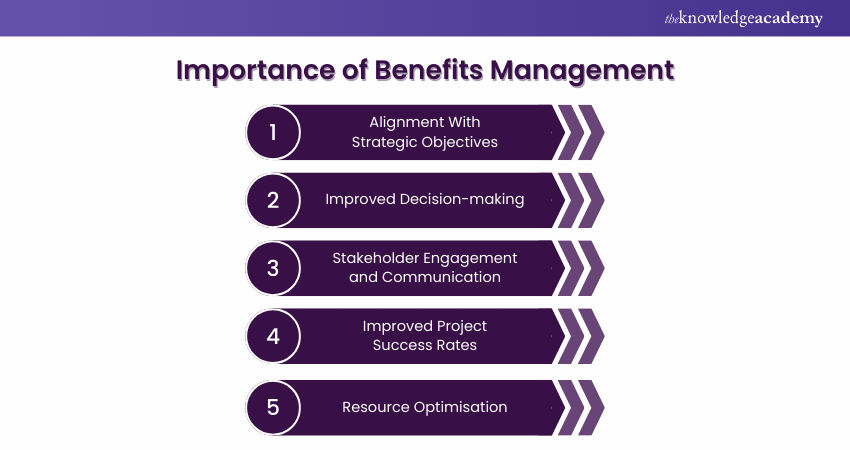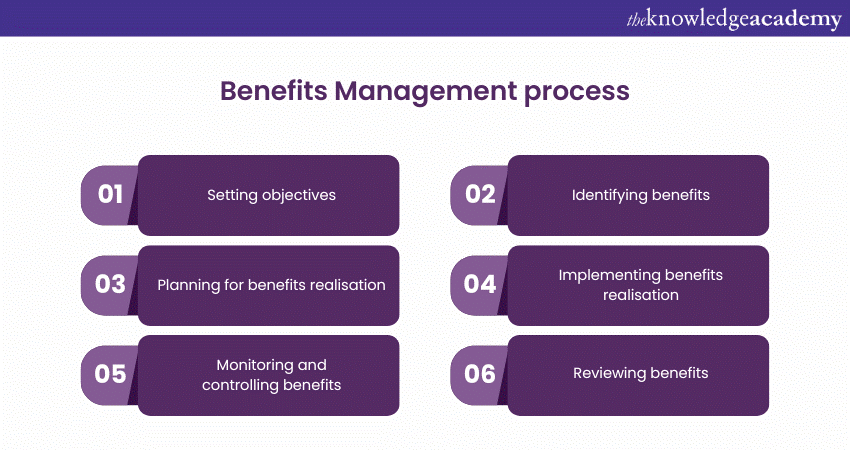We may not have the course you’re looking for. If you enquire or give us a call on 01344203999 and speak to our training experts, we may still be able to help with your training requirements.
We ensure quality, budget-alignment, and timely delivery by our expert instructors.

Have you ever wondered, "What is Benefits Management?" In today's fast-paced business environment, it's crucial to ensure that every project and initiative delivers tangible value. Picture a world where every project not only meets its goals but also contributes significantly to the overall success of the organisation. That's the power of effective Benefits Management.
What exactly does it involve, and why is it so vital? Let's delve in and explore What is Benefits Management, its processes, roles, and the immense value it brings to organisations.
Table of Contents
1) What is Benefits Management?
2) Why is Benefits Management Important?
3) Different Types of Benefits
4) Benefits Management Process
5) Roles and Responsibilities in Benefits Management
6) Conclusion
What is Benefits Management?
Benefits Management ensures that project benefits are clearly defined, planned, achievable, and realised. It starts at the project's outset when Stakeholders present their requirements, establishing intended benefits and providing a focus beyond the project's end date.
Effective Benefits Management involves creating and maintaining a plan to achieve these benefits throughout the project lifecycle. Without active management, the project may deviate, risking the intended outcomes. Project progress and Benefits Management are closely linked; if the project stalls or changes in scope, the benefits may be delayed or unattainable. This process ensures that the project stays on track to deliver its intended benefits.

Why is Benefits Management Important?
Benefits Management is vital for the success and value realisation of projects, programs, and initiatives within an organisation. It offers several key advantages that contribute to overall performance and strategic alignment. Let's explore why this concept is important:

1) Alignment With Strategic Objectives
Benefits Management makes sure projects and initiatives match the organisation's goals. It helps decide if a project is worth doing and if it should be a priority. This alignment ensures that resources are used efficiently for activities that best support the organisation's strategic objectives.
2) Improved Decision-Making
By using this approach, organisations can make better decisions during projects. It helps them evaluate the feasibility and viability of different options and make choices based on evidence. Benefits Management offers a way to assess the costs, risks, and benefits of various alternatives, leading to improved Decision-Making.
3) Stakeholder Engagement and Communication
Effective Benefits Management means involving key stakeholders throughout the project. By including them from the start and regularly updating them on the expected benefits, organisations can build stronger relationships and gain support for the changes. This involvement helps everyone understand the project's goals and expected results.
4) Improved Project Success Rates
Benefits Management offers a clear system to define and track expected benefits during a project. By setting specific metrics and targets, organisations can monitor progress and make needed adjustments to ensure successful benefit delivery. This approach reduces the likelihood of project failure or the realisation of benefits falling short of expectations.
5) Resource Optimisation
Organisations can prioritise their resource allocation and optimise resource usage by focusing on benefits. This allows them to allocate their time, budget, and workforce to projects and initiatives that deliver the most significant returns. As a result, organisations can avoid wasting resources on efforts that may not contribute to the desired outcomes.
Boost your career with our expert-led Managing Benefits™ Courses. Enroll today and master the art of benefits management for successful project outcomes!
Different Types of Benefits
Tangible benefits are measurable and have monetary value. For instance, reducing project costs is a tangible benefit. Assessing such benefits involves using current and historical data to calculate results. Key tangible benefits include:
Tangible Benefits
Tangible Benefits are the kind that an organisation’s project team can measure with convenience and have monetary value. A great example that explains the tangible nature of benefits is the reduction of project costs.
In order to conduct a successful assessment of the implementation of such a benefit, a company can make use of current and historical data to calculate its results. Here are the various Tangible Benefits explained:
a) Optimised Resource Allocation: Benefits Management helps in prioritising projects based on their prospective benefits, ensuring that resources are directed towards the most important and effective operations.
b) Improved Financial Performance: By focusing on projects that offer the greatest returns, Benefits Management contributes to better financial health and profitability.
c) Increased Accountability: Establishing clear goals and metrics for benefits realisation fosters a culture of accountability and performance.
Intangible Benefits
Intangible benefits are those that cannot be quantified or calculated in monetary terms. These benefits are non-physical and have distinct characteristics crucial to Benefits Management:
a) Dynamic Nature: Intangible benefits may evolve over time.
b) Less Static: They are less fixed compared to tangible assets.
c) Forecasting Challenges: Their inherent unpredictability makes forecasting difficult.
d) Non-Monetary: Intangible benefits are not expressed in monetary terms, so they are usually excluded from budgets and financial statements.
Benefits Management Process
Now that you know What is Benefits Management and its types, let’s go through the management process. The Benefits Management process provides a structured approach for organisations to effectively manage and realise the benefits of their projects and initiatives.
It consists of a series of interconnected steps that guide the entire lifecycle of managing benefits. Let’s explore the key stages of the process:

1) Setting Objectives
The first step in the Benefits Management process is to clearly define the initiative's strategic objectives. This involves understanding the organisation's goals, determining the expected outcomes, and aligning the project's purpose with these objectives. Setting defined and measurable objectives provides the foundation for identifying and prioritising the benefits to be achieved.
2) Identifying Benefits
After establishing the objectives, the following step is to identify and define the initiative's advantages. This includes involving stakeholders, taking on a detailed study, and organising the benefits, both tangible and intangible results.
The identification process should consider the expected impacts on financial performance, operational efficiency, customer satisfaction, risk mitigation, and other relevant areas.
3) Planning for Benefits Realisation
Planning for benefits realisation involves setting clear objectives, defining the desired outcomes, and creating a structured plan to achieve them. This includes identifying necessary resources, establishing metrics for success, and continuously monitoring progress. Effective planning ensures that the anticipated benefits are achieved and sustained throughout the project lifecycle, aligning with stakeholder expectations.
4) Implementing Benefits Realisation
Implementing benefits realisation involves executing the plan to achieve desired outcomes. This includes allocating resources, tracking progress against established metrics, and making necessary adjustments to stay on track. Continuous communication with stakeholders and regular reviews ensure that benefits are delivered as expected. This process ensures that the project’s goals are met and its value is realised.
5) Monitoring and controlling benefits
Throughout the project's lifecycle, the benefits must be monitored and controlled to ensure they are on track. This involves evaluating benefit progress against set KPIs, monitoring performance indicators, and comparing actual results to expected targets. Regular reviews and assessments provide an opportunity to identify possible hazards and take appropriate action.
6) Reviewing Benefits
After the initiative is completed, a comprehensive review is conducted to evaluate and compare the actual benefits achieved with the expected benefits. This stage involves analysing the outcomes, documenting lessons learned, and capturing insights for future improvements.
The review process provides valuable feedback to refine future Benefits Management practices and enhance organisational learning.
Learn about the roles in managing benefits with our Managing Benefits™ Foundation Course.
Roles and Responsibilities in Benefits Management
In Benefits Management, various roles and responsibilities are assigned to ensure the effective planning, delivery, and realisation of benefits. A clear Benefits Management Job Description helps define these roles effectively. Here are some common roles and their associated responsibilities:
a) Benefits Owner/Executive Sponsor: They are typically a senior leader within the organisation who takes overall responsibility for successfully delivering benefits. Their responsibilities include setting the strategic direction, securing resources, providing Leadership and support, and championing the Benefits Management process.
b) Benefits Manager: The Benefits Manager is responsible for overseeing the entire process. Their responsibilities include developing and maintaining the Benefits Management Framework and coordinating activities across different teams. They also identify and track benefits and report progress to stakeholders.
c) Project/Program Manager: They ensure that projects and initiatives are aligned with the desired benefits. Their responsibilities include defining project objectives and planning and executing the project. They also monitor progress and manage risks and issues that may impact the realisation of benefits.
d) Stakeholder Engagement Manager: The Stakeholder Engagement Manager identifies and engages relevant stakeholders throughout the process. Their responsibilities include conducting Stakeholder Analysis, communicating benefits, addressing concerns, and ensuring stakeholder involvement and support.
e) Business Analyst: The Business Analyst is crucial in identifying and defining benefits. They gather requirements, analyse business processes, and translate them into measurable benefits. They work closely with stakeholders to ensure that the benefits are clearly defined, aligned with organisational objectives, and realistic.
f) Measurement and Metrics Specialist: This role focuses on establishing appropriate measurement frameworks and metrics to track the progress and performance of benefits. They are responsible for defining KPIs, collecting data, analysing results, and reporting on the achieved benefits.
g) Governance Committee: This Committee provides oversight and guidance to the Benefits Management process. Senior stakeholders and decision-makers typically review and approve benefit definitions, targets, and progress reports. Their responsibilities include ensuring accountability, making key decisions, and resolving issues that may arise.
Unlock the full potential of your organisation's initiatives with our Managing Benefits™ Foundation & Practitioner Course - join now!
Conclusion
Understanding What is Benefits Management is essential for ensuring project success and alignment with strategic objectives. By identifying, planning, measuring, and realising benefits, you can deliver tangible value, meet stakeholder expectations, and keep projects on track. Embrace this approach to transform your projects and drive success.
Gain an in-depth understanding of main Benefits Management concepts with our Managing Benefits® Training - sign up today!
Frequently Asked Questions
What Role Does Benefits Management Play in Career Development?

Benefits Management enhances career development by demonstrating your ability to deliver value through successful project outcomes. It showcases your skills in planning, execution, and strategic alignment, making you a valuable asset.
How do you Measure the Success of Benefits Management?

Success in Benefits Management is measured by comparing the achieved benefits to the planned objectives and metrics set during the planning phase. This ensures alignment with the project's intended value and goals.
What are the Other Resources and Offers Provided by The Knowledge Academy?

The Knowledge Academy takes global learning to new heights, offering over 3,000 online courses across 490+ locations in 190+ countries. This expansive reach ensures accessibility and convenience for learners worldwide.
Alongside our diverse Online Course Catalogue, encompassing 19 major categories, we go the extra mile by providing a plethora of free educational Online Resources like News updates, Blogs, videos, webinars, and interview questions. Tailoring learning experiences further, professionals can maximise value with customisable Course Bundles of TKA.
What is The Knowledge Pass, and How Does it Work?

The Knowledge Academy’s Knowledge Pass, a prepaid voucher, adds another layer of flexibility, allowing course bookings over a 12-month period. Join us on a journey where education knows no bounds.
What are the Related Courses and Blogs Provided by The Knowledge Academy?

The Knowledge Academy offers various Managing Benefits Training, including Managing Benefits Foundation & Practitioner, Managing Benefits Foundation, Managing Benefits Practitioner. These courses cater to different skill levels, providing comprehensive insights into Benefits Management Software.
Our Business Skills Blogs cover a range of topics related to Benefits Management, offering valuable resources, best practices, and industry insights. Whether you are a beginner or looking to advance your Benefits Management skills, The Knowledge Academy's diverse courses and informative blogs have you covered.
Upcoming Business Skills Resources Batches & Dates
Date
 Managing Benefits™ Foundation
Managing Benefits™ Foundation
Mon 16th Jun 2025
Mon 11th Aug 2025
Mon 1st Dec 2025






 Top Rated Course
Top Rated Course


 If you wish to make any changes to your course, please
If you wish to make any changes to your course, please


